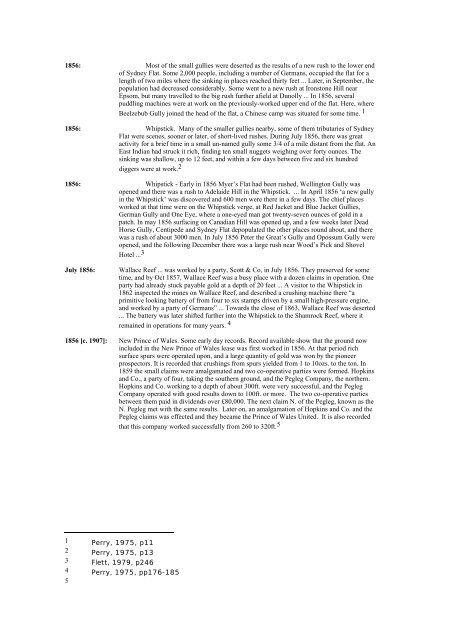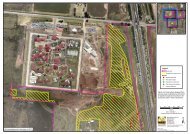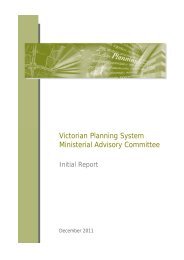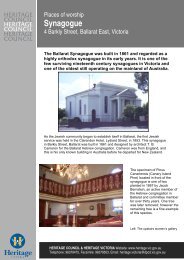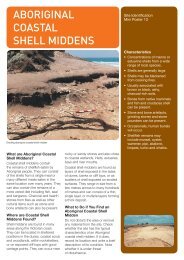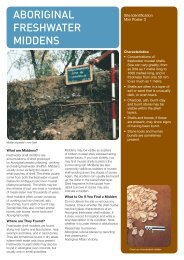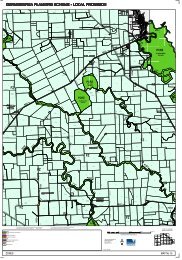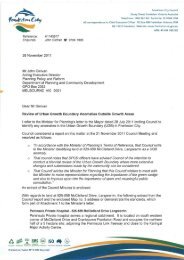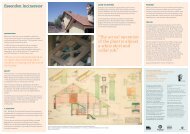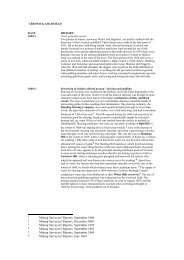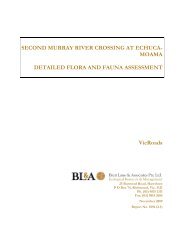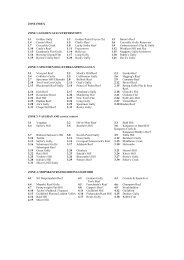Bendigo General History - Department of Planning and Community ...
Bendigo General History - Department of Planning and Community ...
Bendigo General History - Department of Planning and Community ...
You also want an ePaper? Increase the reach of your titles
YUMPU automatically turns print PDFs into web optimized ePapers that Google loves.
1856: Most <strong>of</strong> the small gullies were deserted as the results <strong>of</strong> a new rush to the lower end<br />
<strong>of</strong> Sydney Flat. Some 2,000 people, including a number <strong>of</strong> Germans, occupied the flat for a<br />
length <strong>of</strong> two miles where the sinking in places reached thirty feet ... Later, in September, the<br />
population had decreased considerably. Some went to a new rush at Ironstone Hill near<br />
Epsom, but many travelled to the big rush further afield at Dunolly ... In 1856, several<br />
puddling machines were at work on the previously-worked upper end <strong>of</strong> the flat. Here, where<br />
Beelzebub Gully joined the head <strong>of</strong> the flat, a Chinese camp was situated for some time. 1<br />
1856: Whipstick. Many <strong>of</strong> the smaller gullies nearby, some <strong>of</strong> them tributaries <strong>of</strong> Sydney<br />
Flat were scenes, sooner or later, <strong>of</strong> short-lived rushes. During July 1856, there was great<br />
activity for a brief time in a small un-named gully some 3/4 <strong>of</strong> a mile distant from the flat. An<br />
East Indian had struck it rich, finding ten small nuggets weighing over forty ounces. The<br />
sinking was shallow, up to 12 feet, <strong>and</strong> within a few days between five <strong>and</strong> six hundred<br />
diggers were at work. 2<br />
1856: Whipstick - Early in 1856 Myer’s Flat had been rushed, Wellington Gully was<br />
opened <strong>and</strong> there was a rush to Adelaide Hill in the Whipstick. ... In April 1856 ‘a new gully<br />
in the Whipstick’ was discovered <strong>and</strong> 600 men were there in a few days. The chief places<br />
worked at that time were on the Whipstick verge, at Red Jacket <strong>and</strong> Blue Jacket Gullies,<br />
German Gully <strong>and</strong> One Eye, where a one-eyed man got twenty-seven ounces <strong>of</strong> gold in a<br />
patch. In may 1856 surfacing on Canadian Hill was opened up, <strong>and</strong> a few weeks later Dead<br />
Horse Gully, Centipede <strong>and</strong> Sydney Flat depopulated the other places round about, <strong>and</strong> there<br />
was a rush <strong>of</strong> about 3000 men. In July 1856 Peter the Great’s Gully <strong>and</strong> Opossum Gully were<br />
opened, <strong>and</strong> the following December there was a large rush near Wood’s Pick <strong>and</strong> Shovel<br />
Hotel ... 3<br />
July 1856: Wallace Reef ... was worked by a party, Scott & Co, in July 1856. They preserved for some<br />
time, <strong>and</strong> by Oct 1857, Wallace Reef was a busy place with a dozen claims in operation. One<br />
party had already stuck payable gold at a depth <strong>of</strong> 20 feet ... A visitor to the Whipstick in<br />
1862 inspected the mines on Wallace Reef, <strong>and</strong> described a crushing machine there “a<br />
primitive looking battery <strong>of</strong> from four to six stamps driven by a small high-pressure engine,<br />
<strong>and</strong> worked by a party <strong>of</strong> Germans” ... Towards the close <strong>of</strong> 1863, Wallace Reef was deserted<br />
... The battery was later shifted further into the Whipstick to the Shamrock Reef, where it<br />
remained in operations for many years. 4<br />
1856 [c. 1907]: New Prince <strong>of</strong> Wales. Some early day records. Record available show that the ground now<br />
included in the New Prince <strong>of</strong> Wales lease was first worked in 1856. At that period rich<br />
surface spurs were operated upon, <strong>and</strong> a large quantity <strong>of</strong> gold was won by the pioneer<br />
prospectors. It is recorded that crushings from spurs yielded from 1 to 10ozs. to the ton. In<br />
1859 the small claims were amalgamated <strong>and</strong> two co-operative parties were formed. Hopkins<br />
<strong>and</strong> Co., a party <strong>of</strong> four, taking the southern ground, <strong>and</strong> the Pegleg Company, the northern.<br />
Hopkins <strong>and</strong> Co. working to a depth <strong>of</strong> about 300ft. were very successful, <strong>and</strong> the Pegleg<br />
Company operated with good results down to 100ft. or more. The two co-operative parties<br />
between them paid in dividends over £80,000. The next claim N. <strong>of</strong> the Pegleg, known as the<br />
N. Pegleg met with the same results. Later on, an amalgamation <strong>of</strong> Hopkins <strong>and</strong> Co. <strong>and</strong> the<br />
Pegleg claims was effected <strong>and</strong> they became the Prince <strong>of</strong> Wales United. It is also recorded<br />
that this company worked successfully from 260 to 320ft. 5<br />
1 Perry, 1975, p11<br />
2 Perry, 1975, p13<br />
3 Flett, 1979, p246<br />
4 Perry, 1975, pp176-185<br />
5


